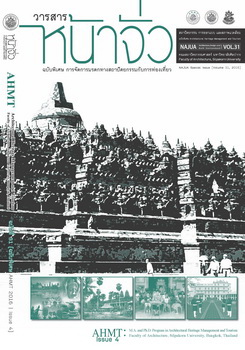Living Heritage through Literature: The Development of Pachit-Oraphim Cultural Routes
Keywords:
cultural routes, toponym, place-names, intangible heritage, cultural mapping, cultural rights, Pachit-Oraphim, literary tourismAbstract
This project studies voices from local communities to preserve and conserve their homeland. Members of these communities wish to use their heritage for identity preservation, as well as to commemorate the complex relationships between Thai, Khmer, and Lao in an area that had never known the word “border ”. The study focuses on cultural and heritage diversity by examining the Pachit-Oraphim local legend. The “Pachit-Oraphim” legend was, for a long time, oral literature before its transcription as Thonburi Literature in a Thai manuscript in the year 1773 by an anonymous writer imitating the Jataka writing style found in the Tripitaka. The story is of the Buddha as Pachit and Phimpa as Oraphim traveling between the old Khmer, Lao, and Thai towns. Everywhere they visited became a place with names.
Interdisciplinary research methods were employed: surveys, in-depth interviews, focus groups, site visits in three countries, and comparisons with similar cases of heritage management in Europe, the Americas, and Asia. The study relates to anthropology, cultural landscape studies, geography, toponymic studies, tourism, marketing, conservation, folklore, cultural mapping, and public administration.
More than thirty cultural landscape sites related to the legend were found on and in the southern portion of the Khorat Plateau along the Phanom Dong Rak Range in Thailand, Cambodia, and Laos. Lao, Korat and Khmer peoples have exchanged this legend as they have migrated into the region. The legend has been carried from generation to generation by people who speak the Thai-Korat dialect and Khmer. The original story is from the Lao. Belief in the legend creates rituals which protect the intangible and tangible cultural heritage. The female protagonist, Oraphim, becomes a goddess who can help a local community’s wishes. People pay respect to the relics and sanctuaries linked to the legend; thus the tangible heritage is kept alive. Connections between the legend’s place-names show that the story is continually retold in local communities and represents layers of time from the pre-historic until the present. Furthermore, the study shows that the routes between local communities give the links between old towns and cities, thus presenting archeaological sites. The research also shows that linkages between communities exist without concern for national boundaries; the people combined the relationships of living heritage from people to people and place to place without national pre-conditions. The results from focus groups and in-depth interviews discussing cultural mapping found that these communities accept the idea of preserving their legends and rituals within a framework of sustainable cultural tourism rather than a concern about the alleviation of poverty.





